CMTUK Conference 2023 – A Post-Conference Round-up
2023’s online CMTUK Conference took place on Friday 21st April and Saturday 22nd April.
It was a chance to learn more about CMT (Charcot-Marie-Tooth) and the latest CMT updates, find out what help is available for the CMT community, as well as meeting people from the community.
The conference covered everything from the latest CMT research, a relaxation session, light chair exercise, a discussion on wellbeing support, useful CMT-related information from our sponsors (Dorset Orthopaedic. ShoeFit and Fledglings) and uncovering benefits.
We have summarised each session below – please scroll down to read on…
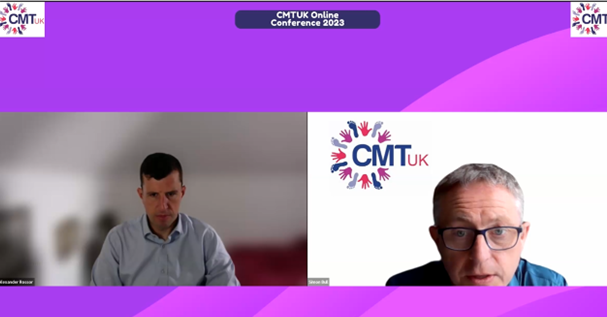
Research Advances in CMT
This talk was given by Alexander Rossor, a consultant and honorary professor at the UCL Queen Square Institute of Neurology, the National Hospital for Neurology and Neurosurgery and Guys and St Thomas’ NHS Foundation Trust. In his talk, he provided an overview of CMT and outlined recent advances in genetic diagnosis and treatments for CMT.
Alex talked about the experimental therapies: CMT1A is the most common type of CMT in the UK and globally. Patients with CMT1A produce too much PMP22 (Duplication of chromosome 17p which contains the PMP22 gene). (Patients with Hereditary Neuropathy with Liability to Pressure Palsies (HNPP) have too little PMP22). PXT3003 from Pharnext is a combination of 3 drugs used in medicine (Naltrexone, Baclofen and Sorbitol) – trials are going on at the moment, which aims to reduce the amount of PMP22 produced. The first trial was published. The study suggested that with the higher dose, there may have been improvements. Then there was a 2nd trial – hopefully we will be getting the results from that shortly.
The 2nd approach is a genetic approach to reduce PMP22: Gene silencing therapy for CMT1A. Synthetic DNA or RNA molecules. It removes mRNA coding for PMP22. This approach is effective (cell in a test tube; not a human being). It is not easy to get synthetic DNA into a nerve cell. It is a little bit of a way off in delivering this for human use.
For treating types of CMT where there isn’t enough of a protein (ie recessive or X-linked CMT), looking to deliver DNA/RNA to nerves to produce proteins. However, it is difficult to get into the nerve cell.
Small molecules (tablets) for CMT – CMT2A is due to mutations in the gene mitofusin 2 (MFN2). MFN2 is expressed in mitochondria. In CMT2A, mitochondria cannot join together properly. A group in the US ‘Mitochondria in Motion Inc’, have created a small molecule drug with easier delivery. The company will be taking this into trial, but it is not quite ready yet.
There is a trial taking place at the moment for a rarer type of CMT – INSPIRE clinical trial (AT-007) for treatment of SORD deficiency.
Hereditary Sensory Neuropathy Serine Trial (SENSE trial) – this is a trial to start with Professor Reilly and Professor Matilde Laura, who will start recruiting in the next few months. 12 months double blind randomised controlled trial of L-serine in patients with HSN1 due to mutations in the SPTLC1 gene.
Barriers for research into CMT are the outcome measures – ie how do you accurately measure how active someone’s CMT is? The other is patient recruitment, especially for rare types of CMT; geographical inequality; many individuals with CMT do not see a neurologist.
UCL has started to develop a UK-wide CMT database, funded by CMTUK. (This is a registry for individuals with CMT in the UK). It is for children and adults, and whether they have seen a neurologist for their CMT. The hope is that people can get involved with research to put their name forward. The registration does not require a healthcare professional. Currently applying for ethical approval.
CMT and the role of Occupational Therapy
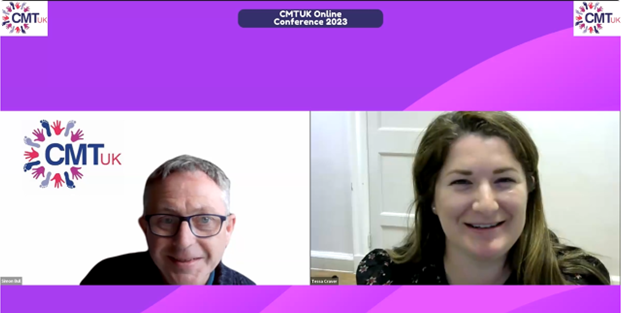
Specialist Occupational Therapist at the National Hospital for Neurology and Neurosurgery, Tessa Craver talked about the Occupational Therapy role in assessment and treatment of people with CMT; disabled facilities grants (DFGs), hand exercises and relaxation meditation session.
The OT role is quite broad – can help with:
- Assessment of your upper limb strength, range of motion, sensation and proprioception, and can come up with a rehab plan in relation to therapy goals.
- Functional and resting splinting.
- Treatment through Activities of Daily Living.
- Work related interventions.
- Sign posting to aids and adaptations.
- Fatigue management education.
- People can contact an Occupational Therapist via out-patient or via social services. Occupational Therapists could also help with a grant from your council if you’re disabled and need to make changes to your home.
- Hand movement is a very important part of managing CMT. Be mindful of grip patterns and hand exercises to maintain muscles. Tessa recommended 3 specific exercises for people with CMT.
Mental Health – the Missing Piece in Rare Disease Care
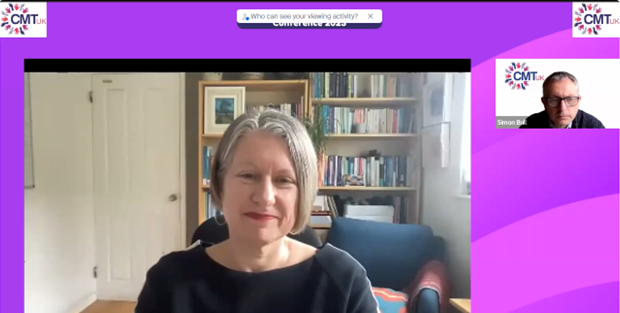
Kym Winter is the Clinical Director and Founder of Rareminds, a UK based non-profit organisation providing specialist psychotherapy, counselling and emotional wellbeing resources to rare disease communities. Kym spoke about rare conditions and mental health. Rareminds is a non-profit organisation set up in 2020 – set up counselling and workshops, group programmes, resources tailored to the needs of rare diseases both generically and specifically. Rareminds also provides support, training and education to patient organisations and healthcare professionals ie ‘supporting the supporters’. In rare disease, physical care is at the fore, but mental health care is very much needed, too and is the ‘missing piece of the puzzle’. There is no lack of evidence for the need of mental health support for those with rare diseases. In a survey from 2018 (Rare Disease UK Report), 95% have felt worried or anxious; 93% have felt stressed; 90% have felt low; 88% have felt emotionally exhausted; 70% have felt at breaking point. Also 46% patients/ 57% carers had never been asked about their mental health/ emotional wellbeing. Kym also talked about the themes across the ‘rare’ experience that impact mental health and emotional wellbeing, such as lengthy or traumatic diagnoses, coping with difficult symptoms, uncertainty, the emotional impact of inheritance, and more. Kym said that living with a rare disease takes emotional energy and to allow periods of rest and recovery. She also talked about different ways in looking after your mental health, such as talking with someone you trust; building relationships (personal support network, medical team, patient community); gaining practical advice; and seeing out targeted techniques and skills such as mindfulness. Kym also gave tips into managing difficult feelings and provided some helpful resources for general anxiety & mood, fatigue, mindfulness courses and books, as well as general mental health support organisations in the UK. Rareminds also asked people to take part in their ‘Rare Minds Matter’ survey, on their rareminds.org homepage, which helps them to know more about the needs of the community.
A discussion then took place with Simon Bull, Chief Executive of CMTUK to find out attendees’ thoughts on working with Rareminds in the future either as a workshop or a group programme.
Uncovering Benefits for Those with a Health Condition or Disability
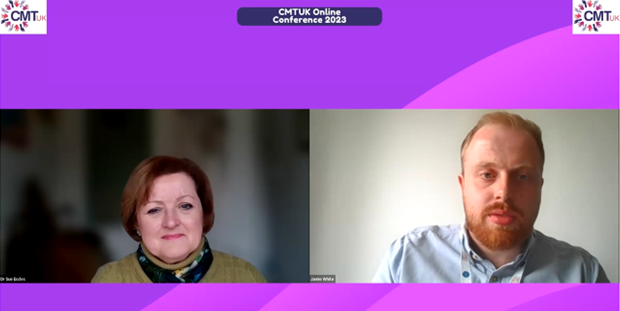
The talk was given by two Citizens Advice Benefits Advisers from Citizens Advice BCP, Jamie White and Dr Sue Eccles.
The cost of living crisis has affected a lot of people and this year has been one of their busiest at Citizens Advice. Citizens Advice is a national charity with over 200 local offices. The charity offers confidential advice online, over the phone, and in person, for free. An overview of welfare benefits were given, including a free and confidential benefits check and free online benefits calculators, which anyone can access. This helps to identify which benefits may be applicable. They talked about 3 types of benefits: non-contributory benefits (not dependant on earnings), including the Disability Living Allowance (up to 16 years old), Personal Independence Payment (from 16 to 66 years old), Attendance Allowance (from 66 years old), Carer’s Allowance, Child Benefit. The 2nd type is contribution-based benefits, ie the New Style Employment and Support Allowance, New Style Jobseeker’s allowance, State pension, statutory sick pay, statutory maternity pay/ maternity allowance, bereavement benefits.
The 3rd type is means-tested benefits: universal credit, pension credit, housing benefit and others such as council tax support, and some legacy (older) benefits.
The Employment and Support Allowance is for if you have a health condition that affects how much you can work – it is only available to people who have been in work for the last 2-3 years. People can apply for ESA once contractual or statutory sick pay (6 months) has been paid by the employer. ESA is based on NI contributions and requires a ‘fit note’.
The Disability Living Allowance: before PIP (Personal Independence Payment) was introduced, DLA was seen to be one of the main disability benefits for adults. DLA is now aimed for new claimants that are under 16 years old who have a disability.
Personal Independence Payment (PIP) was introduced to take the place of DLA for those over 16 years old and is for those who have long term health condition or disability which results in having a difficulty doing day to day activities/ tasks or getting around.
The Attendance Allowance, once individuals reach state pension age, they are unable to claim PIP. Therefore, those over state pension age with mental or physical health care needs can claim Attendance Allowance.
They also went on to talk about specific support available for carers.
CMT Research Update
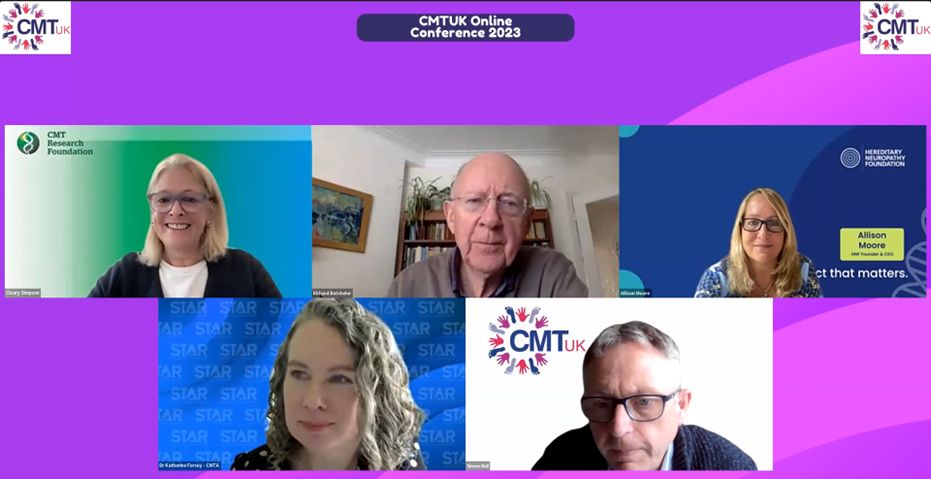
This session included research updates from CMTUK, Royal National Orthopaedic Hospital, CMTRF, CMTA and HNF.
Richard Batchelor gave an update from CMTUK’s research committee, which includes details of the £60k collected in donations for research. The committee seeks to fund research projects that deliver benefits to those with CMT in the short term.
The CMTUK Research Committee funded a project to apply artificial intelligence to images from a CT scanner, which enabled foot surgeons to improve their planning and performance of operations to improve patient outcome.
Richard also discussed the process to invite applications for projects and how awards are offered. CMTUK has made a grant to the development of a national patient registry for CMT with Dr Alexander Rossor and Professor Mary Reilly.
The 2nd project CMTUK is providing funding for: mixed methods investigation into barriers and facilitators of healthy eating in Charcot Marie Tooth disease, with Dr Christopher Morse, Dr Petra Kollic, Dr Gita Ramdharry, Matthew Jacques.
The second presentation was given by Karan Malhotra and Matthew Welck, surgeons from the Royal National Orthopaedic Hospital about the cutting-edge research into CMT feet and improving outcomes of treatment.
The goal of research: classification and nomenclature: progressive collapsing foot deformity. The grant is for software which registers a 3D view with the axis automatically calculated using AI. This then helps to understand the cavus foot better which enables to plan any surgery better and translate into more predictable results in the operation. It also helps to devise new classification to guide treatment. 3 papers on this have been published. A 4th paper is a classification review system of the cavus feet. A 5th paper is also being worked on, determining the remaining deformities, classifying different patterns in different types of feet. Karan and Matt showed the results of operating on a CMTUK member, who watched the conference research update last year and asked to be referred to the hospital for surgery.
Cleary Simpson, CEO of the CMT Research Foundation, gave an introduction to the work of the foundation. The CMTRF has one single focus: to deliver treatments and cures for CMT. They are most focussed on translational research.
The CMTRF research priorities are: advancing gene therapy; promoting nerve health; overcoming the delivery challenge; de-risking clinical trials. There will be a further review of these in 2024. Attracting new researchers in the field is very important to CMTRF. Over the last 5 years, 19 projects have been funded; 4 with clinical candidates; 1 they are planning to take to clinical trials shortly. 5 projects have been completed in the last 5 years. One of those projects was with DTx Pharma, a company with a proprietary technology platform to address the delivery challenge of gene therapies. DTx designed a project for CMT1A with an initial investment from CMTRF. Early results in cell and animal models were promising: DTx earned an NIH grant and subsequently raised more than $100mm in private funding. DTx plans to be in clinical trials for CMT1A with their FALCON sIRNA therapeutic – DTx-1252 – in the next 12 months.
Dr Katherine Forsey, Chief Research Officer at CMTA talked about CMTA’s Strategy to Accelerate Research in Rare Disease. Katherine explained that CMTA is the largest global CMT dedicated Patient Advocacy Group (PAG). Its two main pillars are research and education & support. Their research goal is to develop treatments for CMT via its STAR system (Strategy to Accelerate Research) – $23.5M has been invested since 2008. CMTA is currently supporting over 50 active research studies. It is also currently funding genetic therapy approaches, small molecule testing and gene discovery efforts, as well as clinical trial readiness and biomarkers. CMTA is currently funding Professor Mary Reilly’s ‘SENSE’ trial for patients in the UK. CMTA also provides Alliance Partner Support Services as a pre-clinical testing group, working with organisations such as Shift, Orthogonal, ToolGen. CMTA’s Patients as Partners in Research goal is to advance the CMTA’s strategy to accelerate research and enroll the patient community in the critical work of further the development of treatments, and ultimately a cure, for CMT. Over 6000 patient profiles have been created to date, with over 20 studies supported.
Allison Moore is CEO and Founder of Hereditary Neurology Foundation. Allison talked about HNF’s mission to increase awareness and accurate diagnosis of CMT and related inherited neuropathies; support people living with CMT and their families with critical information to improve quality of life; and fund research that will lead to treatments and cures. HNF created ‘TRIAD’, Therapeutic Research in Accelerated Discovery, a patient-led collaborative network with academia, government and industry, developing treatments for CMT. HNF also created the Global Registry for Inherited Neuropathies (GRIN) to collect patient data to help improve clinical outcomes and learn how they can measure the impact on patients’ lives. One of the stats from the GRIN recognised that 78% of CMT patients experience pain (12% neuropathic, 13% muscular, 5% muscle cramps or spasms in hands or forearms, 70% muscle cramps or spasms in legs/ feet). The registry helps inform researchers on where to focus therapeutic approaches; it can be used as an outcome measure comparison for assessing whether a potential therapy is working; and it also advances understandings of CMT, which can directly translate into improvements in symptom treatment and management outcomes. HNF is also supporting pre-clinical research into CMT4A gene therapy development: behavioural studies in rats. HNF also worked closely with PHARNEXT, in the clinical trial protocol design, site selection and efficient patient recruitment. To join the global registry, visit JoinGRIN.org.
Ask the Sponsors Session
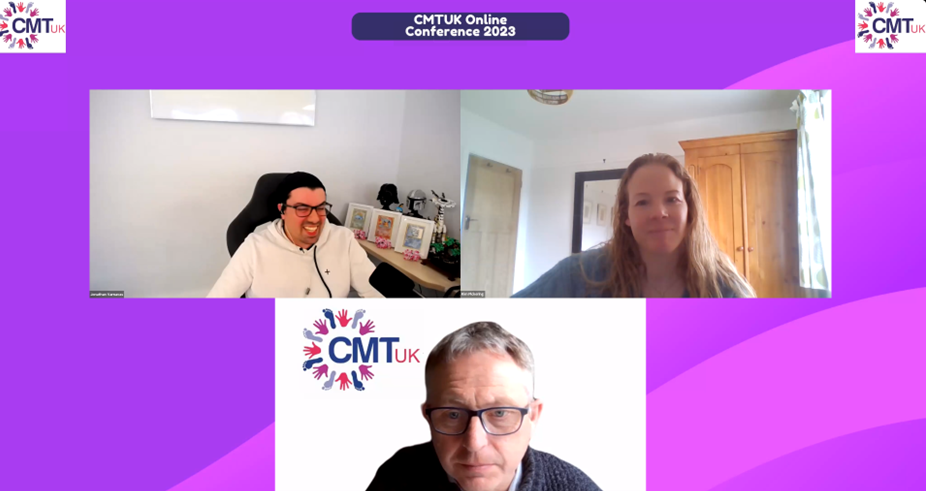
CMTUK would like to extend a big ‘thank you’ to all of our sponsors – without your support, our conference wouldn’t have been possible.
Our sponsors were: Dorset Orthopaedic, ShoeFit.uk and Fledglings.
We also received a grant from Pharnext which helped to support this event.
Two of this year’s sponsors (Dorset Orthopaedic and ShoeFit.UK) gave talks about the latest updates in their CMT-friendly products. Please support them back by reading their information below and getting in touch with them if you would like to know more about their products and services…
Kim Pickering, Orthotist at Dorset Orthopaedic, talked about the orthoses commonly used for CMT. Orthotics work best when combined with physiotherapy to improve muscle strength, as well as Occupational Therapy and Orthopaedic help. Kim explained that an orthosis is a device applied externally to the body in order to improve function, reduce pain or accommodate a difficultly. Kim then went on to explain the orthotic treatment process: the first part is to gain background information, such as doctors reports and details of previous treatments. The assessment includes asking for patients’ outcome goals and any medical interventions taking place. The 2nd part of the assessment includes a physical assessment such as muscle strength, sensation, pain and weight-bearing assessment, gait and ease of movement. There are different orthoses that can be selected, which are discussed and can even be trialled. A cast is then taken, which is a plaster model. Then materials can be manufactured over the top of the cast. Scanning can also be used instead of casts, now. Then the orthotic is produced and fitted, with alterations potentially made. Ankle Foot Orthoses (AFOs) can be plastic or carbon. Turbomeds are designed for running, which attach on the outside of the shoe. Bespoke AFOs are made to cast or scan. Jointed AFOs can be basic right up to dynamic with Dorsiflex assist. SAFOs lift the foot during walking, prevent foot drop and catching of toes. They can be worn with or without a shoe. NHS orthotic departments can be accessed via the GP. Private clinics, including Dorset Orthopaedic, will accept self referral, or can sometimes can be funded via an individual funding request through the NHS.
Please click here to view Dorset Orthopaedic’s website.
Jonathan Varnavas, Company Director at ShoeFit.uk, explained his background as a trained exercise rehabilitator and how ShoeFit.uk works closely with the medical community. Jonathan talked about the anatomy of a shoe: the heel counter (a rigid piece of material that wraps around the heel), which is really important, especially if using orthotics. The shank is used in the heel area to keep the foot stable. Jonathan then described 3 simple tests that can be carried out to test for a supportive and good shoe. 1. The heel counter: use 2-3 fingers to press firmly into the middle of the heel. Congratulate yourself if the back of your shoes didn’t collapse! 2. The shank: turn your shoe over, and hold it with one hand at each end. Twist the shoe both directions to test its stability. 3. The flex point: hold your shoe with one hand at each end again. Bend it with a lot of force. It should only bend in one place – the area where the toes flex. Jonathan then talked about innovations in shoes: rockers (mid-forefoot) & carbon plates (Hoka is a good brand for this); dual density sole units – good for arch support (although not an alternative to orthotics); guidance lines & mid-foot cradles (the way trainers replaces the shank); cushioning and surface mimicry (some brands do this well; others not so well!) For toe deformities, there is ‘stretch leather’ to remove pressure or rubbing. Anyone can book in a video call with ShoeFit via their website if interested to find out more about finding shoes that will work well for your particular feet. ShoeFit.uk also has shoes for non-weight bearing, too. Jonathan also kindly mentioned that there is a range of shoes available for children via Fledglings’ website (Fledglings is another sponsor of the conference). Jonathan also supplied a list of CMT-friendly shoe shops – please click here to view it.
Please click here to visit ShoeFit’s website.
Please keep an eye out for future CMTUK conferences and events on our social media pages or on the news section of this website!
Details correct as of April 2023.


